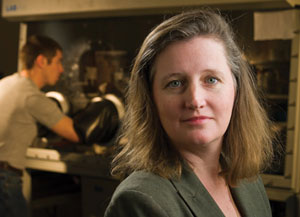| Posted: Nov 02, 2010 |
|
Research on thin-film solar cells heats up at UC Santa Cruz
|
|
(Nanowerk News) Sue Carter, a professor of physics at the University of California, Santa Cruz, is pursuing a variety of strategies to develop cheaper and more efficient solar cells. She was awarded five new grants this year totaling more than $1 million to fund her research on new materials and technologies for solar energy.
|
|
Carter's research focuses on lowering the cost of solar cells and reducing the energy "payback time"--how long it takes a solar cell to generate the amount of energy that was used to manufacture it. Her lab uses thin-film technologies and printable semiconductor materials that enable the production of solar cells using less material and less energy compared to standard manufacturing processes.
|
 |
| Sue Carter, professor of physics, is working to develop cheaper and more efficient solar cells.
|
|
While a growing number of companies are now making thin-film solar cells, conventional silicon-based cells still account for the vast majority of photovoltaic systems in use today. Silicon is a cheap and abundant material, but getting the purity and crystalline structure needed for solar cells requires energy-intensive processing at very high temperatures. And silicon cells have to be thick, because silicon does not absorb light very well.
|
|
Thin-film solar cells use much less material than silicon cells and offer advantages such as light weight and the potential to deposit them on flexible substrates. Cadmium telluride (CdTe) is currently the leading thin-film material, used in solar cells produced by several companies. But tellurium is one of the rarest elements in the world, which could limit the long-term viability of CdTe cells in the solar energy market. Carter's lab has developed a procedure for making ultrathin CdTe solar cells using cheaper processing and only about 10 percent of the material needed to make standard CdTe cells.
|
|
"We do the processing under normal temperatures and pressures, so it uses a lot less energy than vacuum-based processing," Carter said. "And we were able to cut the thickness down from three microns to about 360 nanometers and still get good power efficiencies, so the amount of material you need is almost an order of magnitude less."
|
|
These results were reported in a recent paper in Applied Physics Letters ("CdTe Schottky diodes from colloidal nanocrystals"). Carter's ongoing research to extend this work is funded by a new grant from the California Energy Commission's Energy Innovations Small Grant Program. One of the goals is to deposit the ultrathin CdTe film on a cheap, flexible substrate to make the solar cells more portable, she said.
|
|
Carter's lab is also working to develop thin-film solar cells that use cheaper, more abundant materials than CdTe and the other leading thin-film material, copper indium gallium selenide (CIGS). The indium in CIGS cells is almost as rare an element as tellurium.
|
|
"If we want to scale up solar energy production to terawatt volumes, we need to use more abundant materials," Carter said.
|
|
Alternative thin-film materials being studied in Carter's lab include lead sulfide and copper sulfide. In another recent paper in Applied Physics Letters ("High efficiency mesoporous titanium oxide PbS quantum dot solar cells at low temperature"), she and her co-workers reported high efficiency at low temperature in solar cells using lead sulfide and titanium dioxide nanoparticles (semiconductor crystals with dimensions of a few nanometers). This approach makes use of quantum properties of lead sulfide nanoparticles that could, in theory, enable solar cells to achieve much higher efficiencies than current solar technologies. Ongoing work in this area is funded by a National Science Foundation grant for a collaborative effort involving researchers at UCSC, UC Davis, and industry partners.
|
|
A separate NSF grant is funding Carter's research on copper-based materials for thin-film solar cells. This work is motivated by concerns about the toxicity of cadmium, lead, and other materials used in thin-film solar cells.
|
|
Finally, a Department of Energy grant and an industry grant from Abengoa Solar are funding Carter's work on luminescent solar concentrators. This technology can be used to capture sunlight over a large area and concentrate its energy on a smaller area of solar cells. Many types of dyes, polymers, and other materials can absorb sunlight and then fluoresce, re-emitting the light in a different wavelength. In a luminescent solar concentrator, the fluorescent material is incorporated into a thin, flat sheet. The re-emitted light is guided to the edge of the sheet by "total internal reflection," the same phenomenon that moves light pulses through fiber-optic cables. Solar cells arrayed along the edges convert the light to electricity.
|
|
"One of the nice things about this is that the material can be transparent--it looks like a darkened window. So you can integrate the luminescent solar concentrator and the solar cells into the windows of a building," Carter said. "It's also very cheap material, so you're using a less expensive material to collect the sunlight, and that reduces the amount of expensive solar cells you need."
|
|
Enclosing the film between plates of glass in a water- and oxygen-free environment can prevent degradation of the luminescent material over time, she said.
|
|
Carter's collaborators on these projects include Glenn Alers, adjunct professor of physics; Frank ("Bud") Bridges, professor of physics; industry partners at Abengoa, Add-Vision, and Solexant; and a large number of postdoctoral researchers and graduate and undergraduate students.
|
|
In addition to her lab on campus, Carter and Alers direct the Laboratory for Solar Energy and Renewable Fuels (SERF) at the Advanced Studies Laboratories, a UCSC-NASA partnership at NASA Ames Research Center at Moffett Field. "In the campus labs we do mostly basic science. The SERF lab provides a good setting for applied research and collaborations with industry and NASA partners," Carter said.
|

